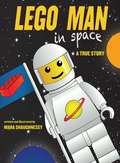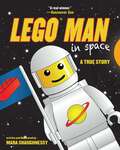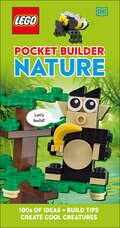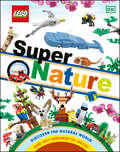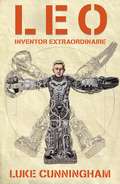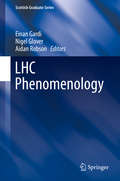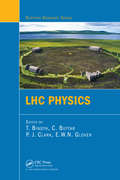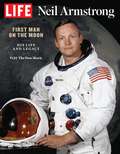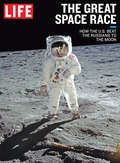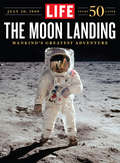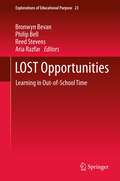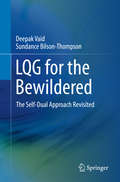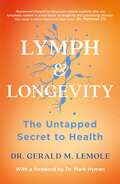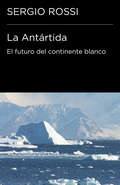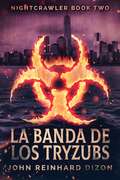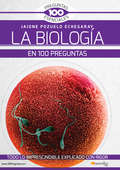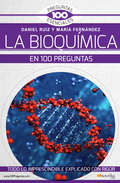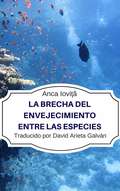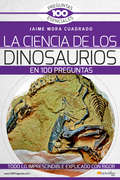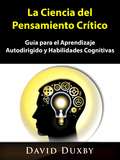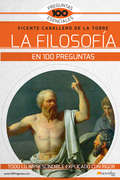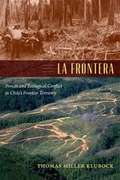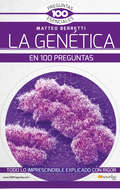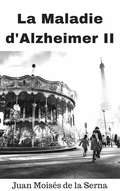- Table View
- List View
LEGO Man in Space: A True Story
by Mara ShaughnessyThe true story of two boys who launched a Lego Man into space! With over 3 million views on YouTube and covered by almost every major news outlet in the world, the story of how two boys launched a Lego man 80,000 feet
LEGO Man in Space: A True Story
by Mara ShaughnessyThe true story of two boys who launched a LEGO man into space! With over 3 million views on YouTube and covered by almost every major news outlet in the world, the story of how two boys, Matthew Ho and Asad Muhammad, launched a LEGO man 80,000 feet into space using a weather balloon, a homemade parachute, and a video camera is truly an inspirational story for all ages. Now you can follow along with the plucky little &“Legonaut&” as he explains just how he became the very first LEGO Man in Space. With bright, original illustrations and loads of fun space facts and activities, kids everywhere will go wild for this true tale of a Legonaut legend and his space adventure. A triumph of science and curiosity, this children&’s book is the first and only book to tell the story of how Mathew Ho and Asad Muhammad accomplished this amazing feat.LEGO Man in Space includes a resource guide for teachers with science activities, classroom crafts and games, and more!
LEGO Pocket Builder Nature: Create Cool Creatures (LEGO Pocket Builder)
by Tori KosaraA one-stop introduction to building with LEGO® bricks for young builders, packed with tips and tricks for making LEGO models of plants, animals, and natural wondersBuild your LEGO® skills with this bitesize guide!Become a LEGO® building expert with stacks of facts, tips, and tricks at your fingertips – no previous building experience required! Get out your bricks and be inspired to build your favorite plants, animals, and natural wonders including a happy hippo, a cool cactus, an incredible volcano, and much more.Each LEGO Pocket Builder book is packed with images of fun-to-make models, building techniques, advice, and inspiration – plus they are perfectly pocket-sized for building anywhere – even on-the-go. Grab your LEGO bricks and go wild!©2022 The LEGO Group.
LEGO Super Nature: Includes Four Exclusive LEGO Mini Models
by Rona SkeneDiscover the natural world with LEGO® bricks! Did you know there's a plant that eats insects? And a mammal that can fly? LEGO® Super Nature is packed full of fascinating facts from the natural world, all illustrated with LEGO builds. Best of all, the book comes with bricks to make four exclusive LEGO minibuilds.From insects, flowers, and trees to mammals, birds, and deepwater fish, LEGO Super Nature takes you on a tour of discovery through the wonders of the natural world. You will learn all about the amazing plants and creatures we share our planet with, their homes and the weird and wonderful things they get up to.Specially commissioned plant and animal builds illustrate the lively text, giving ideas and inspiration for building your own LEGO models.LEGO, the LEGO logo, the Minifigure, and the Brick and the Knob configurations are trademarks of the LEGO Group. All rights reserved. ©2020 The LEGO Group.
LEO the Maker Prince: Journeys in 3D Printing
by Carla DianaLEO the Maker Prince teaches children (both young and old) about 3D printing by following Carla and LEO's journey through Brooklyn. LEO is a walking, talking robot who has the magical ability to to print (in plastic) any object that Carla draws. The other robots have their own special capabilities: H1-H0 prints in metal, Sinclair-10 can find and print objects from a huge catalog of designs, and the others (including AL1C3-D, IRIS-7, and NiXie) have unique talents, too. Readers can come along for the journey, too: all of the objects in the book are printable one way or another.
LEO, Inventor Extraordinaire
by Luke Xavier CunninghamIn this middle-school adventure mystery perfect for puzzle solvers, a young orphan named Leo discovers clues to his past when he finds a series of tunnels below his school. But to unlock the answers, he&’ll need every skill and invention he has—even if his inventions don&’t always work.A &“lifer&” at the secluded Academy of Florence, Leo has never met his parents ... or anyone in his family for that matter. His current &“family&” is his mechanical monkey and robot lion, who along with his charming best friend and fellow lifer, Savvy, only get him into trouble. But after Leo&’s latest experiment goes catastrophically wrong, he finds a mysterious clue that opens an underground maze—one that seems to have been created for him to solve.Leo hopes the tunnels will help him discover the identities of his parents and the reason he&’s an orphan in the first place. Instead, he finds that his past and possibly even his future is somehow linked to the innovative Wynn Toys company, whose genius president mysteriously disappeared years before.Leo must use his creativity and scientific know-how to revive the toy company, oust its dastardly leader, and discover the fate of his real family.LEO, Inventor Extraordinaire:Is perfect for kids 8 to 12 who enjoy action, adventure, humor, and mysteryIs like The DaVinci Code for kids, with robots, wacky inventions, and puzzles to solveContains almost 60 pieces of original black and white artworkEncourages imagination and the development of STEAM skills&“In LEO, Inventor Extraordinaire, Luke Cunningham has created an utterly engaging and charismatic protagonist and an absorbing mystery filled with spectacular inventions, vivid action, an occasional life lesson, and a hearty dose of humor.&” —Clinton Kelly, TV personality and host
LHC Phenomenology
by Einan Gardi Nigel Glover Aidan RobsonThis book covers a very broad spectrum of experimental and theoretical activity in particle physics, from the searches for the Higgs boson and physics beyond the Standard Model, to detailed studies of Quantum Chromodynamics, the B-physics sectors and the properties of hadronic matter at high energy density as realised in heavy-ion collisions. Starting with a basic introduction to the Standard Model and its most likely extensions, the opening section of the book presents an overview of the theoretical and phenomenological framework of hadron collisions and current theoretical models of frontier physics. In part II, discussion of the theory is supplemented by chapters on the detector capabilities and search strategies, as well as an overview of the main detector components, the initial calibration procedures and physics samples and early LHC results. Part III completes the volume with a description of the physics behind Monte Carlo event generators and a broad introduction to the main statistical methods used in high energy physics. LHC Phenomenology covers all of these topics at a pedagogical level, with the aim of providing young particle physicists with the basic tools required for future work on the various LHC experiments. It will also serve as a useful reference text for those working in the field.
LHC Physics
by T. Binoth C. Buttar P. J. Clark E.W.N. GloverExploring the phenomenology of the Large Hadron Collider (LHC) at CERN, LHC Physics focuses on the first years of data collected at the LHC as well as the experimental and theoretical tools involved. It discusses a broad spectrum of experimental and theoretical activity in particle physics, from the searches for the Higgs boson and physics beyond t
LIFE The Great Space Race: How the U.S. Beat the Russians to the Moon
by The Editors of LifeForged in the cauldron of both Nazi Germany and the Soviet Gulag-and fueled by the development of nuclear weapons during the Cold War-The Great Space Race is an epic drama filled with triumphs and tragedies, both technological and deeply human, that riveted the U.S. even as it seemed the fate of the free world (perhaps even the world itself ) hung in the balance.The book features rare, exclusive photographs and thrilling reporting, reflecting LIFE's insider access to the astronauts, their families, and their missions: Go behind the scenes as John Glenn trains for his historic flight, and marvel with Joan Aldrin as her husband, "Buzz," becomes the second man to set foot on the lunar surface. Join Anne Morrow Lindbergh and her aviator husband, Charles, as they visit the Apollo 8 crew on the eve of their historic holiday mission. Watch from the top of the rocket launcher as LIFE's photographer captures the launch of the first manned trip to the moon....and much more.
LIFE The Moon Landing: 50 Years Later
by The Editors of LIFELIFE Magazine presents The Moon Landing: 50 Years Later.
LOST Opportunities
by Reed Stevens Philip Bell Aria Razfar Bronwyn BevanLearning in informal settings is attracting growing attention from policymakers and researchers, yet there remains, at the moment, a dearth of literature on the topic. Thus this volume, which examines how science and mathematics are experienced in everyday and out-of-school-time (OST) settings, makes an important contribution to the field of the learning sciences. Conducting research on OST learning requires us to broaden and deepen our conceptions of learning as well as to better identify the unique and common qualities of different learning settings. We must also find better ways to analyze the interplay between OST and school-based learning. In this volume, scholars develop theoretical structures that are useful not only for understanding learning processes, but also for helping to create and support new opportunities for learning, whether they are in or out of school, or bridging a range of settings. The chapters in this volume include studies of everyday and 'situated' processes that facilitate science and mathematics learning. They also feature new theoretical and empirical frameworks for studying learning pathways that span both in- and out-of-school time and settings. Contributors also examine structured OST programs in which everyday and situated modes of learning are leveraged in support of more disciplined practices and conceptions of science and mathematics. Fortifying much of this work is a leading focus on educational equity--a desire to foster more socially supportive and intellectually engaging science and mathematics learning opportunities for youth from historically non-dominant communities. Full of compelling examples and revealing analysis, this book is a vital addition to the literature on a subject with a fast-rising profile.
LQG for the Bewildered
by Deepak Vaid Sundance Bilson-ThompsonThis primer offers a concise introduction to Loop Quantum Gravity (LQG) - a theoretical framework for uniting Quantum Mechanics (QM) with General Relativity (GR). The emphasis is on the physical aspects of the framework and its historical development in terms of self-dual variables, still most suited for a first, pedagogical encounter with LQG. The text starts by reviewing GR and the very basics of Quantum Field Theory (QFT), and then explains in a concise and clear manner the steps leading from the Einstein-Hilbert action for gravity to the construction of the quantum states of geometry, known as spin-networks, and which provide the basis for the kinematical Hilbert space of quantum general relativity. Along the way the various associated concepts of tetrads, spin-connection and holonomies are introduced. Having thus provided a minimal introduction to the LQG framework, some applications to the problems of black hole entropy and of quantum cosmology are briefly surveyed. Last but not least, a list of the most common criticisms of LQG is presented, which are then tackled one by one in order to convince the reader of the physical viability of the theory. A set of appendices provides accessible introductions to several key notions such as the Peter-Weyl theorem, duality of differential forms and Regge calculus, among others. The presentation is aimed at graduate students and researchers who have some familiarity with the tools of QM and GR, but are intimidated by the technicalities required to browse through the existing LQG literature. This primer aims at making the formalism appear a little less bewildering to the uninitiated and helps lower the barrier for entry into the field.
LYMPH & LONGEVITY: The Untapped Secret to Health
by Dr Gerald M LemoleThe lymphatic system has been one of the most misunderstood systems in our bodies. Until now.Cardiothoracic surgeon Dr. Gerald M. Lemole explains why a healthy lymphatic flow aids our bodies in reducing toxins that contribute to disease and injury. In ten short chapters, Dr. Lemole demystifies the lymphatic system, describes how powerful it is and shows how to maintain a healthy lymph system to combat specific diseases and health problems - from heart disease to cognitive function to weight management.Featuring sidebars with charts and graphs that illustrate basic principles, Lymph & Longevity also includes menus, recipes and information on supplements, as well as basic yoga and meditation guides.Illuminating, informative, and practical this essential guide is timelier now than ever as we continue to work to protect ourselves and our communities against COVID-19 and other viruses.
La Antártida: El futuro del continente blanco (Colección Endebate #Volumen)
by Sergio RossiUn viaje hasta el corazón de la Antártida a bordo del buque oceanográfico Polarstern. El biólogo Sergio Rossi, uno de los pocos privilegiados que ha pisado la mítica tierra de la Antártida, nos acompaña a bordo del buque alemán Polarstern hasta «el fin del mundo», la zona de Larsen, un lugar que los ojos del hombre no han visto jamás. Nos muestra la fauna y flora que habitan la superficie helada y los fondos marinos del continente blanco, y nos explica la importancia crucial de mantener su equilibrio para poder preservar también el equilibrio del planeta.
La Banda de los Tryzubs
by John Reinhard DizonDespués de que los investigadores rusos desarrollaron una milagrosa curación para el VIH, la Corporación Trident empieza las pruebas beta de la droga en los Estados Unidos. Sabrina se enreda en una red internacional de intriga, mientras los terroristas están usando el proyecto como cobertura para atacar en suelo americano. Enseguida, un ataque terrorista sacude a Wall Street. Es hora de que el Merodeador Nocturno entre en acción nuevamente. Pero esta vez, el amor de Sabrina Hoyt está en el centro de la acción. Con la guerra entre los carteles de la droga destruyendo todo a su alrededor, podrá Sabrina llevar a los criminales a la justicia--y proteger a su prometido.
La Biología en 100 preguntas (100 Preguntas esenciales)
by Jaione Pozuelo EchegarayLas respuestas de la ciencia a las preguntas más relevantes en el campo de la Biología: el origen de la vida, los niveles de organización de la materia viva, la genética, la evolución, la biodiversidad, la salud y el funcionamiento del cuerpo humano. Esta obra le ayudará a entender el proceso más maravilloso del universo: la vida. El origen de la vida – La herencia genética – Evolución- Biodiversidad- Salud y enfermedad- El cuerpo humano ¿Existen los mutantes?, ¿Perderemos los dedos de los pies con la evolución?, ¿Se puede trasplantar el cerebro? , ¿Existe vida en otro lugar del universo?, ¿Existen clones de seres humanos?, ¿En qué se basa la teoría del gen egoísta?, ¿Están vivos los virus?, ¿Es cierto que solo usamos el 10 % del cerebro?, ¿Es posible lograr la inmortalidad?, ¿Cuántas bacterias viven dentro de nuestro cuerpo? Rigor y amenidad reunidos en una colección de “alta divulgación”. Libros rigurosos pero de fácil lectura, que podrá disfrutar incluso cuando solo disponga de unos momentos. Un recorrido completo y seductor por los grandes temas del conocimiento humano. Un viaje maravilloso al mundo de la ciencia y la cultura.
La Bioquímica en 100 preguntas (100 Preguntas esenciales)
by María Fernández OrganistaLas respuestas de la química de la vida al prodigio de la biodiversidad. Todas las claves fisicoquímicas que desentrañan el “misterio de la vida”: desde el agua y el carbono hasta los grandes complejos macromoleculares y las técnicas industriales y clínicas que han cambiado la sociedad: La estructuración de la materia viva, la biología molecular y el genoma, la bioenergética y el metabolismo, la bioquímica aplicada y la genética. ¿Se puede cambiar el color de los vegetales?, ¿Están vivos los virus?, ¿Es realmente malo el colesterol? , ¿Podrían existir humanos con ojos en las palmas de las manos?, ¿Es posible la vida sin ADN? , ¿Qué es un reloj molecular?, ¿Pueden ser venenosas las vitaminas?, ¿Es verdad que respirar nos hace envejecer?, ¿Hay bisturís que huelen el cáncer?, ¿Podemos estudiar el genoma de Tutankamon?, ¿Cómo se obtiene un transgénico? El misterio de la vida ha representado desde siempre una cuestión central en el pensamiento humano. Su origen, su funcionamiento o su diversidad son fenómenos que todos alguna vez hemos querido explicar. La Bioquímica aborda el fenómeno de la vida desde un punto de vista estrictamente molecular, lo que nos está permitiendo desentrañar los secretos más íntimos de la vida. Esta obra acerca al gran público el estado actual de la Bioquímica. A través de 100 preguntas sencillas se da explicación a términos y fenómenos con los que nos encontramos todos los días y que esta ciencia trata de entender. En tono divulgativo, pero altamente riguroso, se presenta desde la descripción de algunas de las más sorprendentes maquinarias macromoleculares, hasta la explicación de por qué nos sale un chichón al sufrir un golpe en la cabeza. Todo ello desde los principios más básicos de la Bioquímica a la aplicación industrial de este conocimiento.
La Brecha del Envejecimiento Entre las Especies
by Anca IoviţăEl envejecimiento es un rompecabezas a resolver. Este proceso es tradicionalmente estudiado en algunos modelos biológicos como moscas de fruta, gusanos y ratones. Lo que todas estas especies tienen en común es su rápido envejecimiento. Esto es excelente para el presupuesto del laboratorio. Es una gran estrategia a corto plazo. ¿Quién tiene tiempo de estudiar especies que viven por décadas? Pero las diferencias de duración de vida entre las especies son magnitudes de orden mayor que cualquier variación lograda en el laboratorio. Esta es la razón por la cual estudié incontables fuentes de información en un intento por reunir información altamente especializada en un libro fácil de seguir. Quería ver el bosque entre los árboles. Quería exponer la brecha del envejecimiento entre las especies en una secuencia lógica y fácil de seguir. Este libro es mi intento de hacer precisamente eso. ¿Cuáles son los mecanismos subyacentes de la brecha de envejecimiento entre las especies? He elegido intencionalmente escribir la respuesta a esta cuestión en un lenguaje claro. La investigación del envejecimiento es muy importante como para enconderla tras las puertas cerradas del argot científica formal. Este libro podría no haber exisitdo si el té verde, las bibliotecas y el internet no hubieran sido inventados. La cantidad de datos que tuve que explorar para mantener los patrones esenciales es enorme. Sin embargo, el libro no es exhaustivo. No es un aburrido y académico libro de texto. Intenté infundir vida en un tema que es enormemente importante para la extensión de la esperanza de vida humana. Solo tú puedes decidir si lo logré. ***************** Tabla de Contenidos ********************** Encontrando el Bosque Entre los Árboles Ser Confiable Cuenta Las Matemáticas del Envejecimiento La Velocidad de la Senescencia Caso de Estudio: Envejecimiento en Peces Cómo Estimar
La Ciencia de los Dinosaurios en 100 preguntas (100 Preguntas esenciales)
by Jaime Mora CuadradoLas claves científicas del fascinante mundo de la Paleontología de los dinosaurios. Su origen y descubrimiento, su evolución, extinción y el mundo en que vivían. Un recorrido exhaustivo por los interrogantes y temas más controvertidos, con rigor y amenidad teniendo en cuenta los descubrimientos y estudios científicos más recientes. ¿Qué hizo que los dinosaurios fuesen los amos de la tierra?, ¿Cuál es el eslabón perdido entre reptiles y aves?, ¿Pudo vivir algún dinosaurio en la Antártida?, ¿Hubo un invierno nuclear hace 65 millones de años?, ¿Por qué sobrevivieron los cocodrilos y no los dinosaurios a la extinción?, ¿Así que ahora hay que imaginar al terrible Tiranosaurio... con plumas?, ¿Cómo una especie de un metro se transforma en otra de cuarenta metros?, ¿Podemos crear un dinosaurio a partir de un pollo?, ¿Siguen entre nosotros?
La Ciencia del Pensamiento Crítico: Guía para el Aprendizaje Autodirigido y Habilidades Cognitivas
by David Duxby¿Te gustaría poder pensar de forma crítica con una mente clara? ¡Durante mucho tiempo, las técnicas del pensamiento crítico se han utilizado para permitir que las personas tomen mejores decisiones en literalmente todos los aspectos de sus vidas! ¡Usar técnicas de pensamiento crítico también ayudan a presupuestar, ganar dinero, vivir bien, comer sano, tomar las mejores decisiones posibles, para mejorar los niveles de energía, concentración, felicidad general y mucho más! Experimenta emociones más positivas y una mejor calidad de vida al desarrollar esta habilidad esencial. Using critical thinking techniques will also help with budgeting, earning money, living well, eating healthy, making the best possible decisions, energy levels, focus, overall happiness, and much more! Experience more positive emotions and a higher quality of life by building this essential skill. ¡Presentamos los secretos que los profesionales del pensamiento crítico utilizan para ser más eficiente! ¡Con décadas de estrategias probadas, este libro electrónico le mostrará la forma más rápida y efectiva de usar el pensamiento crítico para beneficiar su bienestar! Esta guía le enseña técnicas probadas sin el uso de suplementos o cursos caros. Qué está incluido: - Tomar mejores decisiones. - Tener relaciones más sanas. - Hacer más dinero. - Tener más energía. - Comer mejor. - Reducir y eliminar la ansiedad. - Tener más energía. - Dormir mejor. - ¡Supere las dolencias, los obstáculos y los problemas de la vida con facilidad! - Lo que debería saber. + MUCHO MAS! Si desea estar más saludable o mejorar el enfoque y el bienestar, esta guía es para usted. -> Desplácese hasta la parte superior de la página y haga clic en Agregar al carrito para comprar al instante Descargo de responsabilidad: El aut
La Filosofía en 100 preguntas (100 Preguntas esenciales)
by Vicente Caballero de la TorreLos temas clave para sumergirse en el apasionante y complejo mundo de la Filosofía, ordenados por temas y descritos con rigor académico en un lenguaje ameno y divulgativo. ¿Qué es la Filosofía?, metafísica, ontología, los límites del conocimiento, el hombre en el cosmos, filosofía de la religión, filosofía y economía, sociedad y política, arte y estética. Todas las respuestas a las preguntas que siempre se ha hecho. ¿Sabías que la filosofía oriental está tan de moda porque vivimos en tiempos de crisis?, ¿Existe Dios o nos lo hemos inventado?, ¿Cómo podemos distinguir las paraciencias de las ciencias?, ¿Qué quiso decir Descartes con su «Pienso, luego existo»?, ¿Tenemos un cuerpo o somos nuestro cuerpo?, ¿Somos realmente libres o la libertad es una ilusión?, ¿Se pueden educar las emociones?, ¿Necesitamos realmente vivir en sociedad o estaríamos mejor en soledad?, ¿Será posible la paz para siempre?, ¿Sabías que los economistas discuten más por Filosofía que por Economía?, ¿Hay una belleza objetiva o cualquier cosa puede ser bella para alguien y fea para otro?
La Frontera: Forests and Ecological Conflict in Chile’s Frontier Territory
by Thomas Miller KlubockIn La Frontera, Thomas Miller Klubock offers a pioneering social and environmental history of southern Chile, exploring the origins of today's forestry "miracle" in Chile. Although Chile's forestry boom is often attributed to the free-market policies of the Pinochet dictatorship, La Frontera shows that forestry development began in the early twentieth century when Chilean governments turned to forestry science and plantations of the North American Monterey pine to establish their governance of the frontier's natural and social worlds. Klubock demonstrates that modern conservationist policies and scientific forestry drove the enclosure of frontier commons occupied by indigenous and non-indigenous peasants who were defined as a threat to both native forests and tree plantations. La Frontera narrates the century-long struggles among peasants, Mapuche indigenous communities, large landowners, and the state over access to forest commons in the frontier territory. It traces the shifting social meanings of environmentalism by showing how, during the 1990s, rural laborers and Mapuches, once vilified by conservationists and foresters, drew on the language of modern environmentalism to critique the social dislocations produced by Chile's much vaunted neoliberal economic model, linking a more just social order to the biodiversity of native forests.
La Genética en 100 preguntas (100 Preguntas esenciales)
by Matteo BerrettiLas respuestas de la ciencia a las cuestiones clave de la Genética: los organismos transgénicos, clones y mutaciones, la epigenética, la bioética, el papel de los genes en nuestras emociones, la estructura del ADN, la ingeniería genética y la medicina predictiva. ¿Cómo se construye un organismo desde el ADN?, ¿Se pueden crear mutantes?, ¿Cómo funciona el virus del SIDA?, ¿Qué es una dieta genética?, ¿Cómo se crea una planta transgénica?, ¿Para qué sirven los biochips?, ¿Existen los bebés a la carta?, ¿Existe el gen de la inmortalidad?, ¿Qué es la genética de poblaciones?, ¿Qué es un reloj molecular?
La Maladie D'Alzheimer II
by Juan Moises de la SernaComment traite-t-on la maladie ? Quelle est son évolution ? Comment la prévient-on ? Découvrez les dernières avancées en matière de prévention et de traitement de la maladie d'Alzheimer. L'une des questions les plus importantes que l'on se pose face à une maladie, quelle qu'elle soit, est de savoir comment l'affronter, c'est-à-dire si des remèdes existent et quels sont les traitements. À cet égard, des progrès ont lieu constamment dans le domaine de la recherche sur le traitement et la prévention de la maladie d'Alzheimer : c'est ce que nous présentons dans ce texte.
